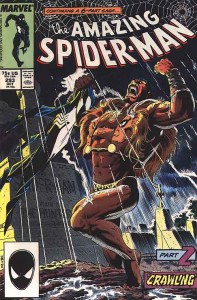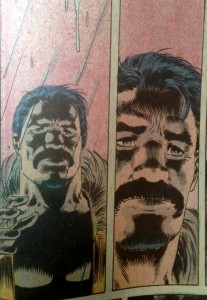When I open the pages of a Spider-Man comic, I don’t expect to find horror. That changed when I read “Kraven’s Last Hunt.” The six part story by J.M. DeMatteis and Mike Zeck spread across the Web of Spider-Man, The Amazing Spider-Man, and The Spectacular Spider-Man in 1987, and it’s the kind of story that puts hooks into your brain that you can’t shake it off. The tale of Kraven burying Spider-Man alive and donning his uniform is scary and not quite like anything I’ve read in a superhero comic before. While I paused at the end of each issue to ask myself what in the world I had just read, I can appreciate the creative storytelling on display – both in words and art.
It was interesting to meet Kraven in his final story (well, it is comics so it’s probably not his last appearance) rather than starting with his origin. I’m not sure I’d take this approach with any new-to-me character, but with Kraven, it worked. His motivations were immediately apparent. He’s not subtle, but DeMatteis also referenced enough about his past to make it easy to understand Kraven. Or, at least begin to understand him. Kraven doesn’t have the sort of mind I’d want to thoroughly explore.
He’s one bizarre guy, and the flow of the comic matches that trait. It’s trippy. The pages jump from Kraven to Vermin to Spidey to Mary Jane, and the pacing is such that you don’t have time to pause – you want to get to the next page. An aspect of the story that contributed to the weird vibe is the subtext that runs throughout the issues. We continually get a peek into each character’s internal dialogue even though they may be saying different things. Following the flow of the words is tricky at first, but once you get used to it, you appreciate the depth it adds to the story.
Having that additional layer is especially important for Kraven. Without his running commentary, he would seem crazy for no reason. With it, we know his twisted thoughts. He is the greatest hunter and to prove himself, he thinks he needs to kill Spider-Man and take his place. He sort of succeeds with part one of his plan, and he fails at part two. He thinks Spider-Man is no more than a human in a suit and that he can easily replicate his heroics, but Kraven doesn’t understand all the ingredients that go into becoming a superhero.
He takes out thugs, but he injures them enough to require hospital care. Or worse, he kills them. He lacks compassion, and when he sees Spider-Man refrain from killing Vermin, the light bulb flips on. He turns on his heel and realizes what he can’t be, what Spidey is, and he finds peace. And his final bow is a punch to the gut.
The addition of the internal dialogue also pulled back the curtains on Peter’s fears. He was out of the world for two weeks. He’s recently married Mary Jane and neither she or Aunt May have any idea where he’s been, and he admits to being scared and worried. Invulnerable heroes have weaknesses, too. They’re super humans, and I appreciate when stories illustrate those aspects.
Much of the imagery in “Kraven’s Last Hunt” is striking and memorable. No, I’m not talking about naked Kraven or seeing Peter Park lounge around in his underwear (I am a little disappointed that they were tighty-whities and not red and blue boxers), I mean the action scenes and the strange beauty of Kraven’s last moments. The color palette is darker and broody, the poses are dynamic, and the facial expressions speak volumes. This shot of Kraven in part 5 slays me:
Look at all the emotion in his eyes. Mike Zeck and Bob McLeod did a tremendous job at conveying the mood.
I may have started “Kraven’s Last Hunt” with a raised eyebrow and a confused look on my face, but by the time I finished the six part saga, I was satisfied. Not happy – that wouldn’t be right – but satisfied. And more than a little spooked.



Comments are closed.